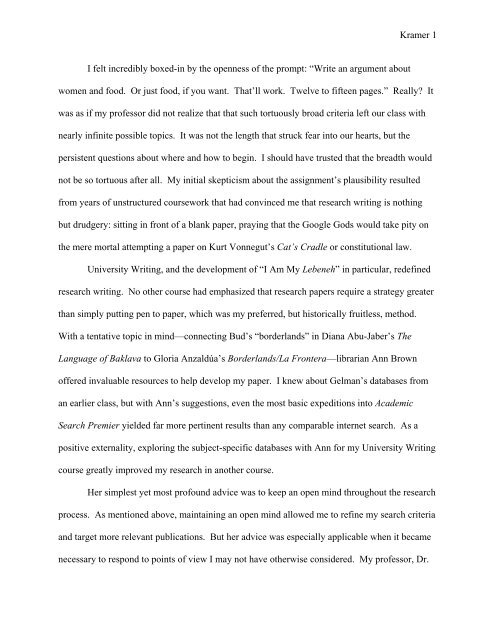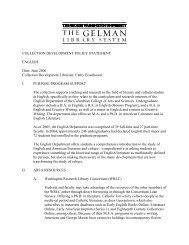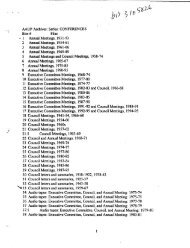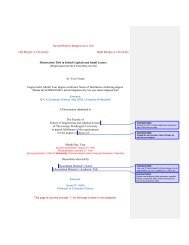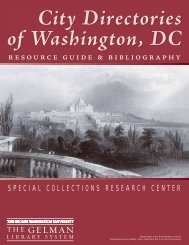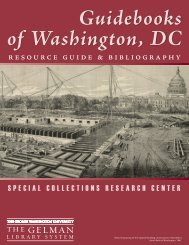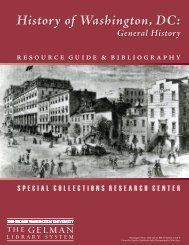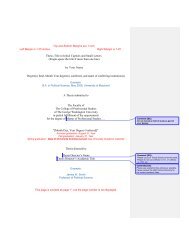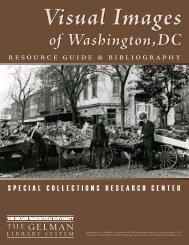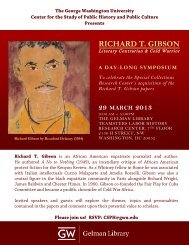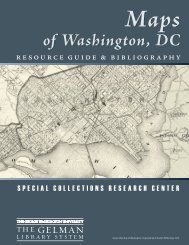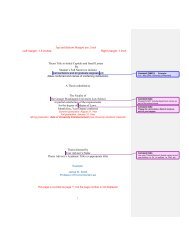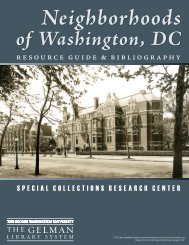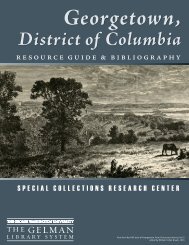I Am My Lebeneh - GW Libraries
I Am My Lebeneh - GW Libraries
I Am My Lebeneh - GW Libraries
- No tags were found...
You also want an ePaper? Increase the reach of your titles
YUMPU automatically turns print PDFs into web optimized ePapers that Google loves.
Kramer 1I felt incredibly boxed-in by the openness of the prompt: “Write an argument aboutwomen and food. Or just food, if you want. That’ll work. Twelve to fifteen pages.” Really? Itwas as if my professor did not realize that that such tortuously broad criteria left our class withnearly infinite possible topics. It was not the length that struck fear into our hearts, but thepersistent questions about where and how to begin. I should have trusted that the breadth wouldnot be so tortuous after all. <strong>My</strong> initial skepticism about the assignment’s plausibility resultedfrom years of unstructured coursework that had convinced me that research writing is nothingbut drudgery: sitting in front of a blank paper, praying that the Google Gods would take pity onthe mere mortal attempting a paper on Kurt Vonnegut’s Cat’s Cradle or constitutional law.University Writing, and the development of “I <strong>Am</strong> <strong>My</strong> <strong>Lebeneh</strong>” in particular, redefinedresearch writing. No other course had emphasized that research papers require a strategy greaterthan simply putting pen to paper, which was my preferred, but historically fruitless, method.With a tentative topic in mind—connecting Bud’s “borderlands” in Diana Abu-Jaber’s TheLanguage of Baklava to Gloria Anzaldúa’s Borderlands/La Frontera—librarian Ann Brownoffered invaluable resources to help develop my paper. I knew about Gelman’s databases froman earlier class, but with Ann’s suggestions, even the most basic expeditions into AcademicSearch Premier yielded far more pertinent results than any comparable internet search. As apositive externality, exploring the subject-specific databases with Ann for my University Writingcourse greatly improved my research in another course.Her simplest yet most profound advice was to keep an open mind throughout the researchprocess. As mentioned above, maintaining an open mind allowed me to refine my search criteriaand target more relevant publications. But her advice was especially applicable when it becamenecessary to respond to points of view I may not have otherwise considered. <strong>My</strong> professor, Dr.
Kramer 2Smith, hosted valuable peer review sessions with several classmates. Beyond providingconstructive criticism on diction and organization, Dr. Smith and my classmates positedquestions that I had not contemplated, and my argument evolved in response to these newfindings. Thus, my interaction with other thinkers shaped my topic just as much as my topicguided my research.I enjoyed extensive access to publications on Borderlands/La Frontera, which providedassurance in framing my argument. <strong>My</strong> interpretation of “How to Tame a Wild Tongue” isnothing particularly novel, as the idea that language is important to Anzaldúa is central to manyof the texts I read throughout the process. However, I did contribute something new: a closetextual analysis of “How to Tame a Wild Tongue” coupled with a pilot study of The Language ofBaklava. The openness fostered by Ann and my colleagues in the peer review sessions becamecrucial upon discovering the dearth of publications on The Language of Baklava, which was achallenge I did not face in my research on Borderlands/La Frontera. Instead of absorbing theideas of published scholars, I was forced to trust the value of my observations on the memoir, asno standard for comparison exists. The lack of resources on The Language of Baklava, which atfirst seemed problematic, allowed me to participate in academic discourse as a universityfreshman in ways I never expected was possible.This paper was thrilling to write, in spite of—or perhaps because of—the challenges Ifaced as a researcher. I am thoroughly interested in the idea of the borderlands but am not amember myself. Because I cannot personally relate to a life on the border, it was important torigorously analyze the texts at hand rather than infuse an outsider’s perceptions into theargument. Based on my experience, I believe that the topic could encourage those who may nototherwise read a text by a lesbian Chicana feminist philosopher to think about her incredibly
Kramer 3insightful work by relating it to something more accessible: a memoir about food that reads like anovel. I hope that readers can learn from reading my paper, because I certainly learned fromwriting it.
Kramer 4Maris KramerDr. Caroline SmithUW 020: The Politics of the Kitchen16 April 2010I <strong>Am</strong> <strong>My</strong> <strong>Lebeneh</strong>AbstractThis paper examines how the culinary traditions of Bud’s homeland in DianaAbu-Jaber’s memoir, The Language of Baklava, help Bud manage a lifecomprised of two cultures. Bud, Abu-Jaber’s immigrant father, struggles to unitethe memories of his Jordanian childhood with the realities of his new life inSyracuse, New York. Abu-Jaber notes that, as immigrants, her father and hisbrothers live in the “borderlands” between their new and native cultures (326).Gloria Anzaldúa presents this term in Borderlands/La Frontera, and it is uponthis concept that the paper is based. Anzaldúa’s use of language, as presented inher chapter “How to Tame a Wild Tongue,” reinforces her position in theborderlands yet serves as a mechanism to manage conflicting identities and, inturn, construct her own. Similarly, Bud’s Jordanian culinary habits separate himfrom <strong>Am</strong>erican culture yet allow him to form a new identity amidst the strains ofdisplacement. In this way, Bud uses food to negotiate life in the borderlands asAnzaldúa uses language.In “Language and Identity Politics: The Linguistic Autobiographies of Latinos in theUnited States,” Lea Ramsdell contends that feminist philosopher Gloria Anzaldúa is “situated inbicultural, bilingual contexts” and writes “in an attempt to reconcile [her] two languages into acoherent identity (168). The chapter “How to Tame a Wild Tongue” from Borderlands/LaFrontera illustrates Ramsdell’s assertion. Anzaldúa states that language, an essential element ofhuman interaction, is integral to her identity as a tejana living in the borderlands, the regionwhere her Spanish- and English-speaking backgrounds intersect. In the memoir The Languageof Baklava, Diana Abu-Jaber’s father, Bud, is situated in his own borderlands between <strong>Am</strong>ericaand his Jordanian homeland. Abu-Jaber presents food as essential to Bud’s identity as he
Kramer 5reconciles childhood memories and lived realities in the borderlands. As such, many ofAnzaldúa’s musings about language are applicable to Bud’s culinary practices in the memoir.Although the spectrum of human experience exhibits wide variation, language and food arewidely acknowledged as aspects important to a person’s sense of self. What is lacking, however,is an extensive analysis detailing the similarities between the two elements in constructing theidentities of those who associate with not one culture but many. In The Language of Baklava,Bud’s relationship with food corresponds to Anzaldúa’s relationship with language in “How toTame a Wild Tongue.” Food helps Bud manage the demands of conflicting cultures as languagedoes for Anzaldúa. Bud eventually realizes that he need not transcend the border between oneculture and another; food allows him to embrace life in the borderlands and define his ownidentity. Although the cases of Anzaldúa and Bud are only two cases of many, analyzing theircomparable experiences in the borderlands can enhance the discussion of minority identificationmore broadly.Existing ResearchGloria Anzaldúa’s Borderlands/La Frontera is considered a seminal work in feminist andChicana studies. In her “Introduction to the Second Edition” of Borderlands/La Frontera, SoniaSaldívar-Hull contends that Borderlands “signaled a new visibility for academic programs on thestudy of the U.S.-Mexico border [to include] History, <strong>Am</strong>erican Studies, Anthropology andPolitical Science” (12-13). Beyond the impacts listed above, Borderlands has also intensifiedthe academic discussion on the role of language in identity formation. Cristina Ros i Solé writesabout the use of L2, or combined second language, to construct linguistic and cultural identitiesin non-native or displaced persons like Anzaldúa in “Autobiographical Accounts of L2 IdentityConstruction in Chicano Literature.” Discussion of language in Borderlands/La Frontera and,
Kramer 6specifically, “How to Tame a Wild Tongue” can also be found in Ramsdell’s “Language andIdentity Politics.”On the contrary, there are very few publications about The Language of Baklava and littlescholarly analysis. The extent of writings on the text are opinion pieces, like “Memoirs” byJoyce Saricks, and book reviews, such as “The Language of Baklava: a Memoir” by Pat Bangs,Jackie Gropman, and Susan Woodcock. In neither context is the memoir analyzed in any depth.While secondary sources on The Language of Baklava are scarce, many scholars have written onthe overarching importance of food to Abu-Jaber’s fictional characters. Referring to one of Abu-Jaber’s novels, Carol Fadda-Conrey observes, “from her pivotal position in the kitchen, [theprotagonist joins] together the different communities and individuals of Crescent’s ethnicborderland” (196). Brinda Mehta has also interpreted the role of food in Crescent, noting theimportance of culinary practices to the identities of <strong>Am</strong>ericans of foreign descent. Therefore, itis not surprising that Abu-Jaber’s account of Bud and his struggle to unify Jordanian and<strong>Am</strong>erican culture concentrates on food. Yet although Bud’s character and the memoir as awhole can greatly contribute to academic discussion of food, displacement, and identity, TheLanguage of Baklava has remained on the shelf. This paper acknowledges food’s importance toBud and presents its role in helping him cope with conflicting demands of separate cultures.Borderlands: Crossfire Between CulturesBefore analyzing the two texts, it is necessary to define the concept of “borderlands.” Inthe poem “To live in the Borderlands means you” from Borderlands/La Frontera, Anzaldúadescribes residents of the borderlands as “caught in the crossfire between camps” of races,ethnicities, foods, and languages (216). As the cacophonous alliteration in the quote suggests, lafrontera is a place in which people face conflictual demands of multiple cultures. Notably,
Kramer 7where there is crossfire, there are wounds. Borderlands can be physical; Anzaldúa grew up inTexas near a physical border between two countries and cultures. However, the notion ofborderlands is applicable to those without such tangible boundaries. For example, mostimmigrants must travel far to reach the United States. As a result, their personal borderlands donot consist of physical boundaries between new and native lands. Instead, the borderlandscombine memories of their homeland with the realities of new surroundings. The result: a “dualidentity” (Anzaldúa 85).The TextsBorderlands/La Frontera discusses conflicts of linguistic, sexual, and ethnic identity thatexist on the border of Mexico and the United States, conflicts which are particularly influentialon its author. Anzaldúa is one of many writers who “view language as the very essence of theirselves” (Ramsdell 167). Anzaldúa articulates in “How to Tame a Wild Tongue” that “ethnicidentity is twin skin to linguistic identity;” the languages she possess wield extraordinaryinfluence over her cultural identification (81). Her concise assertion that “I am my language”reinforces this point. She combines both Spanish and English to emphasize the significance ofthe multifaceted position from which she writes. Yet Anzaldúa also depicts the nearimpossibility of reconciling the cultures her speech reflects. When she speaks English, shespeaks “the oppressor’s language” (77); when she speaks Chicano Spanish, she speaks “anorphan tongue” (80). As a result, the implications of language on her identity are, at times,problematic. Since the English speakers she must accommodate deem her tongue “illegitimate,”she deems herself illegitimate (81). However, the chapter’s tone does not solely reflectfrustration and irreconcilable conflict. <strong>Am</strong>idst the struggles of life in the borderlands, Anzaldúa
Kramer 8is resilient and even hopeful. She will use her native tongue to “overcome the tradition ofsilence” indicative of life in the borderlands and, by speaking, establish her legitimacy (81).It is true that Anzaldúa is uniquely situated since she perceives that her languages—amalgams of Spanish and English—are considered “bastard” (80) by the English “oppressor”(77). Not all minority groups experience such discordant interactions with the dominant culture.Although Bud endures his share of contention, his relationship with <strong>Am</strong>erican society is hardlyas antagonistic as Anzaldúa’s. However, many of the experiences Anzaldúa articulates in “Howto Tame a Wild Tongue” are useful in analyzing Bud’s relationship to food in The Language ofBaklava.Abu-Jaber’s memoir presents direct observations on experiences of a first-generationimmigrant to the United States. At the beginning of the text, Abu-Jaber does not call Bud “Arab-<strong>Am</strong>erican,” a hyphenated designation typical of minorities in the United States. Instead, she saysthat she is “raising an Arab father in <strong>Am</strong>erica” (3). The physical separation of the words “Arab”and “<strong>Am</strong>erica” parallels the disconnect Bud notices between his Jordanian homeland and<strong>Am</strong>erican life. The word “raising” suggests that Bud is dependent on his <strong>Am</strong>erican family tofamiliarize him with the intricacies of <strong>Am</strong>erican society and help him adapt. However, as thememoir progresses, Bud no longer feels this estrangement or dependence. Decades after theopening scene, readers find Bud in a Jordanian restaurant, reminiscing over Arabic food with achildhood friend. When Bud’s friend admits, “I thought you were an <strong>Am</strong>erican,” Bud reveals, “Iam” (313). Despite this seemingly dramatic change—what appears to be a sacrifice of oneculture for another—a critical fact remains. No matter the circumstances, Bud never abandonsthe foods of his homeland. Arabic food helps Bud manage the conflicts of life in the borderlandsand form an identity within them. While Bud cannot recreate in Syracuse, New York his
Kramer 9childhood amongst the Bedouins, he can recreate the scents and tastes that remind him of his firsthome. Thus, he is able to establish a new life and identity in <strong>Am</strong>erica without forgoing hisconnection to Jordan. Bud, initially an Arab man living in <strong>Am</strong>erica, is now an Arab-<strong>Am</strong>erican.Notably, the identity-defining elements in each text—language and food—relate to thetongue. At the most basic level, the tongue allows for certain sounds in oral communication andfacilitates eating; an organ that encourages interpersonal interaction and helps sustain life, thetongue is an invaluable component of the human experience. “How to Tame a Wild Tongue”opens with three anecdotes from visits to the dentist’s office, where the presumably oppressivedentist desires to “control” Anzaldúa’s “strong” and “stubborn” tongue (76). Yet wild things areundomesticated, nonconformist, and generally free from the confines of a restraining power.Anzaldúa’s “wild tongue” remains wild to the last page, as the dominant culture is unable totame her, linguistically or otherwise. As the following analysis indicates, the inhospitable natureof the borderlands does not stifle Bud’s tongue, either; food helps him reconcile his identities andhis tongue remains wild.Linguistic and Culinary Identities in “How to Tame a Wild Tongue” and The Language ofBaklavaFor both Anzaldúa and Bud, language and food derive their meanings from specificcultural settings. The connotation of certain phrases may vary when uttered in English orSpanish, just as a dish from Jordan may not retain the same significance if it is eaten in an<strong>Am</strong>erican restaurant. Although Anzaldúa’s Spanish phrases are often accompanied bycomparable English phrases, she writes many items in Spanish precisely because they cannot beexpressed in English. “Muchachitas bien criadas” is followed by the translation, “well-bredgirls don’t answer back” (76). Despite Anzaldúa’s English translation, people living on the other
Kramer 10side of the border may not understand the relational hierarchies and power politics embedded inthe statement if they lack insight into Mexican-<strong>Am</strong>erican culture. In this case, Spanish is a toolthat systematically reinforces Anzaldúa’s position in the Mexican-<strong>Am</strong>erican borderlands yetoffers her avenues of expression not available in English alone.The meaning of food, too, can be lost in translation. In The Language of Baklava, Abu-Jaber converts the names of some foods into English: “magloubeh […] means upside-down,” adescription of the dish’s preparation method (128). However, for many dishes, language andfood are intractably linked; the dishes and their names do not have English equivalents. Abu-Jaber provides no translation for the dish lebeneh, only details of its white, therapeutic purity.Just as Anzaldúa offers English renditions of Spanish sayings, Abu-Jaber attempts literal andfigurative descriptions such as “yogurt,” “cream,” and “mother’s milk.” In the end, though,lebeneh “is the sort of food that can’t be replaced by anything else” (229). The dish is plainlyArabic and reflects a culture not widely represented and recognized in <strong>Am</strong>erican society. Thelebeneh tucked inside Bud’s <strong>Am</strong>erican refrigerator emphasizes his location on the Jordanian-<strong>Am</strong>erican border but helps preserve part of his character.To some extent, the “hatred, anger and exploitation” of the border “landscape”necessitate Anzaldúa and Bud to compartmentalize their cultural identifications to preserve ahealthy sense of self (Anzaldúa 19). To cope with the stressors of the borderlands, Anzaldúauses different languages in different settings. At home with her sister, brothers, and friends,Anzaldúa speaks variations of Spanish that have emerged on the Mexican-<strong>Am</strong>erican border. Insettings where white culture is dominant, such as “school […] and job situations,” Anzaldúaspeaks “standard and working class English” (78). Anzaldúa comments that if she accidentallyuses a language out of its intended context, she ostracizes herself and those with whom she is
Kramer 11speaking. Ironically, to “talk freely” and be understood, she must exhibit only those aspects ofher identity which are appropriate on a particular side of the border.Bud encounters a similar issue on the border between his native Jordan and new home inSyracuse. In the first chapter of The Language of Baklava, Abu-Jaber notes that her family is“Arab at home and <strong>Am</strong>erican in the streets” (5). This statement indicates that the context inwhich it is appropriate for Bud to exhibit Jordanian qualities is in the privacy of his family’shome. Outside of their house, “<strong>Am</strong>erican” behavior is expected by society, a notion exemplifiedby the following example from The Language of Baklava. After years of deliberation, Budfinally opens his own restaurant. It is not a Jordanian restaurant that serves the Arabic food ofhis childhood but rather an <strong>Am</strong>erican restaurant on an <strong>Am</strong>erican golf course that offersarchetypal <strong>Am</strong>erican cuisine: “rows of burgers, sizzling French fries, blistering hot dogs, andgrilled cheese sandwiches” (324). Abu-Jaber notes that her father is happy “feeding people andwatching them eat,” even if the food they consume is not Arabic. The restaurant, Bud acting“<strong>Am</strong>erican in the streets,” represents his compartmentalized identities.However, by definition, to live in the borderlands is to occupy more than one culture.Realistically, neither Anzaldúa nor Bud can seclude themselves from the <strong>Am</strong>erican side of theborder, nor is it likely that they would desire this isolation. After all, Anzaldúa defines herselfnot by speaking Spanish but by alternating between and juxtaposing Spanish and English in avariety of contexts. In her refusal to speak English alone, the surrounding English-speakingculture may consider both her and her language inferior. For example, when she instructs her“Anglo teacher” how to pronounce her name correctly, she is punished for “talking back” (75).However, rather than conceding to the demands of the teacher’s side of the border, Anzaldúaembraces the languages “closest to [her] heart” (78), and in so doing, defines herself as neither
Kramer 12“hispana india negra española ni gabacha” but as a unique combination of all (216). Languageallows Anzaldúa to construct her own border identity.Like Anzaldúa, Bud’s Jordanian food and cooking practices essentially ostracize himfrom <strong>Am</strong>erican society yet allow him to retain particularly meaningful aspects of his nativeculture. Returning to the example of his <strong>Am</strong>erican restaurant, Bud was able to partition hisidentities only to a limited extent. Two years after Bud finally achieved the object of hisdesires—a family-run restaurant in <strong>Am</strong>erica—he decides to sell it. Bud recognizes theimplausibility of maintaining such clearly-defined arenas of identity as the restaurant. Ratherthan identify with Jordan or the United States exclusively, Bud effectively constructs his ownborder identity. He incorporates elements of one culture into his life in another, even at the riskof receiving negative reactions from the dominant <strong>Am</strong>erican culture. In a particularly tellinganecdote, Abu-Jaber writes, “the front lawn will allow us to share food, cross our legs on theplastic lawn chairs, and gossip with the neighbors, as we did in Jordan.” But they do not live inJordan. They live in Syracuse, New York, where “the neighbors don’t barbeque in their frontyards” (78). Here, Bud integrates Jordanian traditions into his <strong>Am</strong>erican life. The day aftercooking in the front lawn, young Diana learns that her classmate’s parents consider Bud’s frontyardcooking to be an “unholy disgrace.” The classmate proceeds to threaten the Abu-Jabers:“‘If your family doesn’t know how to behave, my parents will have to find out about getting youout of this neighborhood’” (82).The previous statement is notable for two reasons. In the eyes of a middle-class<strong>Am</strong>erican family in white suburbia, Bud misbehaved by cooking in the manner of his homeland.The family decides that good behaviour is <strong>Am</strong>erican and bad behaviour is Jordanian. Thisdiction ascribes to <strong>Am</strong>erican identity a certain privilege, a privilege that can be revoked by the
Kramer 13dominant culture; practicing Jordanian traditions becomes a punishable offense. The statementis also emblematic of Bud’s life in the borderlands. If he continues to unite his two worlds bymaking Arabic foods in his suburban <strong>Am</strong>erican community, he faces conflict and isolation.Yet the risk of conflict is not enough to prevent Anzaldúa from using an array oflanguages or Bud from steadfastly making the foods of his homeland. The two experienceceaseless tension between aspects of themselves, but they eventually come to realize that thistension does not make their multiple identities mutually exclusive. They do not live on one sideof the border, but in the borderlands. The borderlands, where cultures coalesce, are a worthyplace to live. To thrive in the borderlands, neither Anzaldúa nor Bud abandons aspects of theircharacters under “the hammer blow of the dominant norteamericano culture” (Anzaldúa 85).The hammer blow, while violent, reinforces and fastens together the seemingly disjointed piecesof Anzaldúa and Bud into coherent identities. Language and food are the nails.Anzaldúa’s use of language signifies that her “position is one of both appropriation andresistance” (Aigner-Varoz 47). She does not surrender her border tongue and the identity towhich it is linked, for it has rendered her “persevering [and] unbreakable” (Anzaldúa 86). Herpurpose in writing “How to Tame a Wild Tongue” and Borderlands/La Frontera is neither torecoil toward the Mexican border nor produce a polemical against oppressive <strong>Am</strong>erican society.She appropriates attributes of the white border as she writes predominantly in English butintersperses a multiplicity of dialects that resist dominant expectations to emphasize her subjectposition in society. Anzaldúa calls her multilingual work an “invitation” to dialogue among allsectors of society (20). The noun “invitation” embodies Anzaldúa’s progression in acceptingherself and her language, with language defining her in turn. “Invite” is an active verb;Anzaldúa actively calls upon each open-minded person to engage in meaningful discussion on
Kramer 14issues of ethnicity, language, sexuality, and many others. Her tongue may emphasize herlocation on the Mexican-<strong>Am</strong>erican border, but it exerts such power in doing so. Where Englishalone may have caused her to fade into the background, to be swallowed by the borderlands, her“illegitimate” wild tongue ironically allows her to establish her legitimate sense of self.Bud, too, appropriates aspects of the society to which he migrated, but he resists thestatus quo by persistently cooking Arabic food. Bud <strong>Am</strong>ericanizes throughout the memoir, butnot once do the recipes depart from their Jordanian origins. The only non-Arabic recipes withinThe Language of Baklava—namely Velveeta sandwiches, angel food cake, and crème puffs—areassociated with other family members. From the author’s youth in Catholic school to herFulbright research as an adult in Jordan, her father cooks Arabic food. Jordanian culinarytraditions in suburban Syracuse are not widely accepted, and may in fact be a misbehaviour thatjustifies expulsion from the neighborhood. But like Anzaldúa’s book, Bud’s cooking is aninvitation to all to accept his border identity. Bud does not barbeque in the front yard to bereclusive, to retreat toward his Jordanian childhood, but rather to “share food […] and gossipwith the neighbors” (78). Bud’s food is an open invitation, if society is willing to accept. Hisfood distinguishes him from white <strong>Am</strong>erica but helps him establish his place within it. Throughfood, Bud comes to realize he need not be exclusively <strong>Am</strong>erican or Jordanian. He can be both.Bud, like Anzaldúa, establishes his identity with his wild tongue.ImplicationsIn "Language and Identity Politics," Lea Ramsdell notes that “there is no universal Latinoexperience of language” for Anzaldúa or any of the writers she discusses. However, Ramsdellclaims each writer recognizes “that the evolution of a private and public self is conditioned bylanguage” (168). Similarly, this paper does not contend that language and food are
Kramer 15homogenously important to all minorities living in majority worlds. There is still much to bediscovered about identity formation, but the preceding analysis of two seemingly disparate textsis a valuable launching point in broadening the discourse regarding the nature of identity in thecontext of majority-minority relations. Anzaldúa’s relationship to language and Bud’s to foodare clearly emblematic of life in the borderlands. Despite the differences between the two, theyprovide comparable tools to manage the conflict inherent to the border between cultures. Furtherstudies may show that residents of other borderlands can contribute valuable mechanisms fordealing with this conflict as well. These methods could, in turn, limit the wounds that arise inthe crossfire.Anzaldúa and Bud are able to legitimize their identities through language and food.What is clear, however, is that this should not have been necessary in the first place. The UnitedStates is widely acknowledged as a melting pot of ethnicities, religions, and creeds. Despite theincredible openness of this nation, the hands with which it embraces minority groups can alsostifle and repress. If <strong>Am</strong>erican society as a whole is unwilling to accept and encouragedifference, English-speakers will not hear Anzaldúa’s Spanish phrases, no matter her pleas tolisten; Bud’s lebeneh will bridge no cultural gaps. Yet if they are willing to listen to wildtongues and the language of baklava, <strong>Am</strong>ericans can learn from the resilience of Anzaldúa andBud.
Kramer 16Works CitedAbu-Jaber, Diana. The Language of Baklava. New York: Anchor Books, 2005. Print.Aigner-Varoz, Erika. "Metaphors of a Mestiza Consciousness: Anzaldua's Borderlands/LaFrontera." MELUS 25.2 (2000): 47-62. Academic Search Premier. Web. 3 Apr. 2010.Anzaldúa, Gloria. Borderlands/La Frontera. San Francisco: Aunt Lute Books, 1999. Print.Bangs, Pat, Jackie Gropman, and Susan Woodcock. "The Language of Baklava: A Memoir."School Library Journal 51.9 (2005): 246. Academic Search Premier. Web. 10 Mar. 2010.Fadda-Conrey, Carol. “Arab <strong>Am</strong>erican Literature in the Ethnic Borderland: CulturalIntersections in Diana Abu-Jaber’s Crescent.” MELUS 31.4 (2006): 187-205. AcademicSearch Premier. Web. 27 Feb. 2010.Mehta, Brinda J. “The Semiology of Food.” Rituals of Memory in Contemporary Arab Women’sWriting. Syracuse: Syracuse University Press, 2007. 228-262. Print.Ramsdell, Lea. "Language and Identity Politics: The Linguistic Autobiographies of Latinos inthe United States." Journal of Modern Literature 28.1 (2004): 166-176. Academic SearchPremier. Web. 27 Mar. 2010.Ros i Solé, Cristina. "Autobiographical Accounts of L2 Identity Construction in ChicanoLiterature." Language & Intercultural Communication 4.4 (2004): 229-241. Linguisticsand Language Behavior Abstracts. Web. 15 Apr. 2010.Saldívar-Hull, Sonia. “Introduction to the Second Edition.” Borderlands/La Frontera. SanFrancisco: Aunt Lute Books, 1999. 1-15. Print.Saricks, Joyce. “Memoirs.” Booklist 104.13 (2008): 48. Academic Search Premier. Web. 4. Mar.2010.


